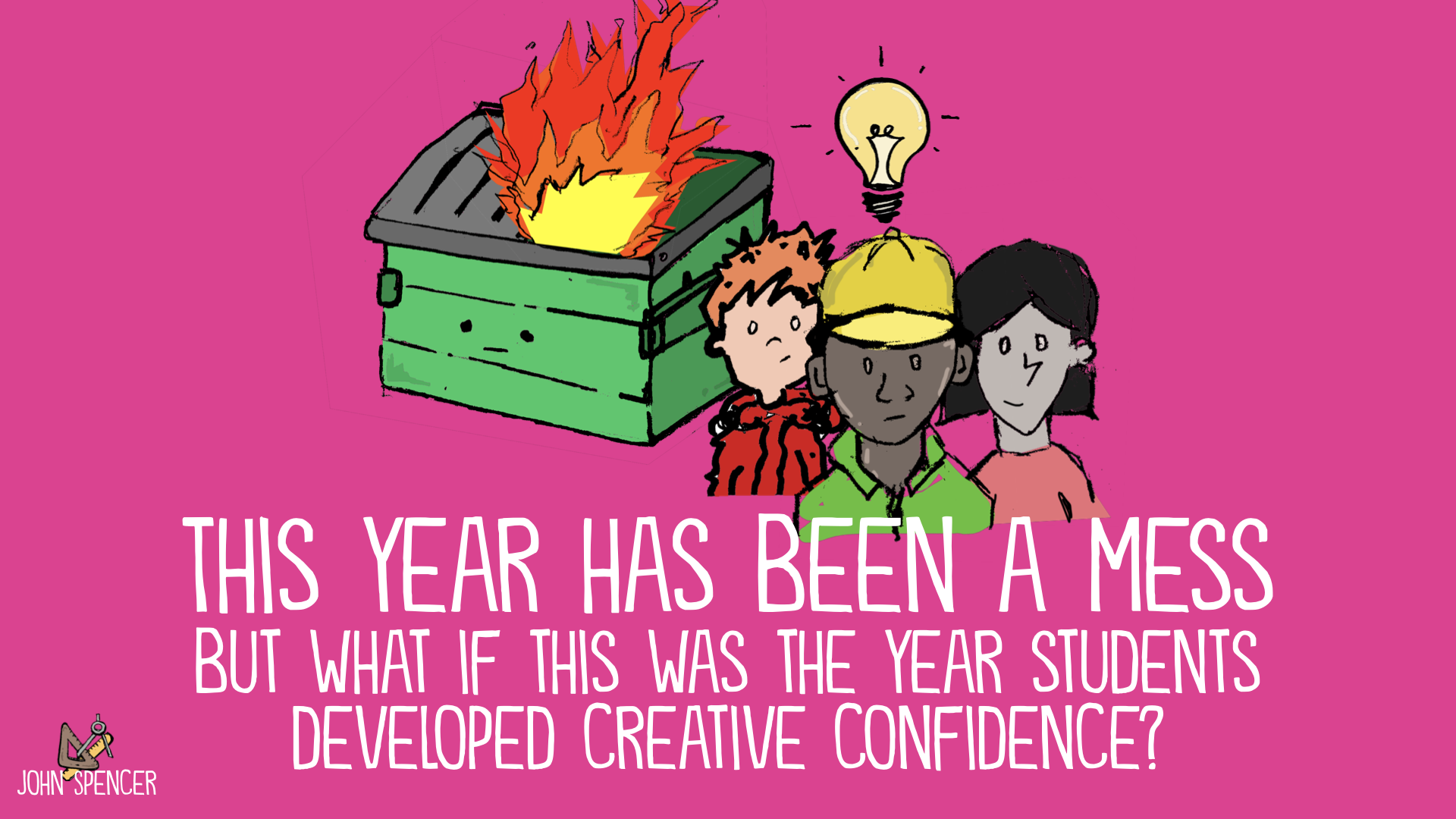7 Ways to Build Creative Confidence in Students
Education Rethink 2020-12-04
Sometimes I wish I could go back in time to visit my 9-year old self and say, “Dude, you got this. Right now, it’s hard but someday you’ll be using your voice to make art. Trust me, it gets better. Way better.”
I was in speech therapy at the time. I can’t entirely remember why. I just remember that the therapy was actually pretty fun and my speech therapist was pretty awesome. I was never bullied for the way I spoke. However, somehow I internalized the idea that there was something wrong with my voice. I always felt insecure about the way I spoke. Fast forward 31 years and I use my voice all the time in my work. I record podcasts and create sketch videos, like the writing prompt I just recorded yesterday:
In the last seven years, I have spoken at the White House, given a TEDX Talk and traveled around the world giving keynotes and conducting workshops. I have spent the last seventeen years getting in front of students and doing direct instruction. I have made countless instructional videos for my virtual and online classes and I’ve created five different self-paced professional development courses.
I have found my voice.
So what happened?
One key moment was when I competed in the National History Project in eighth grade. It was a massive, year-long project that involved interviewing former Negro League baseball players and eventually putting together a multimedia presentation. I remember being terrified of talking to strangers and pushing through the fear to do the interviews. Toward the end of the project, I recorded a script and when it was played back, I heard my recorded voice for the first time and begged Mrs. Smoot to let me quit. That’s when she said, “When you hide your voice, you rob the world of your creativity. I’m not going to let you do that.”
She had me re-record my script again and again until I found my voice.
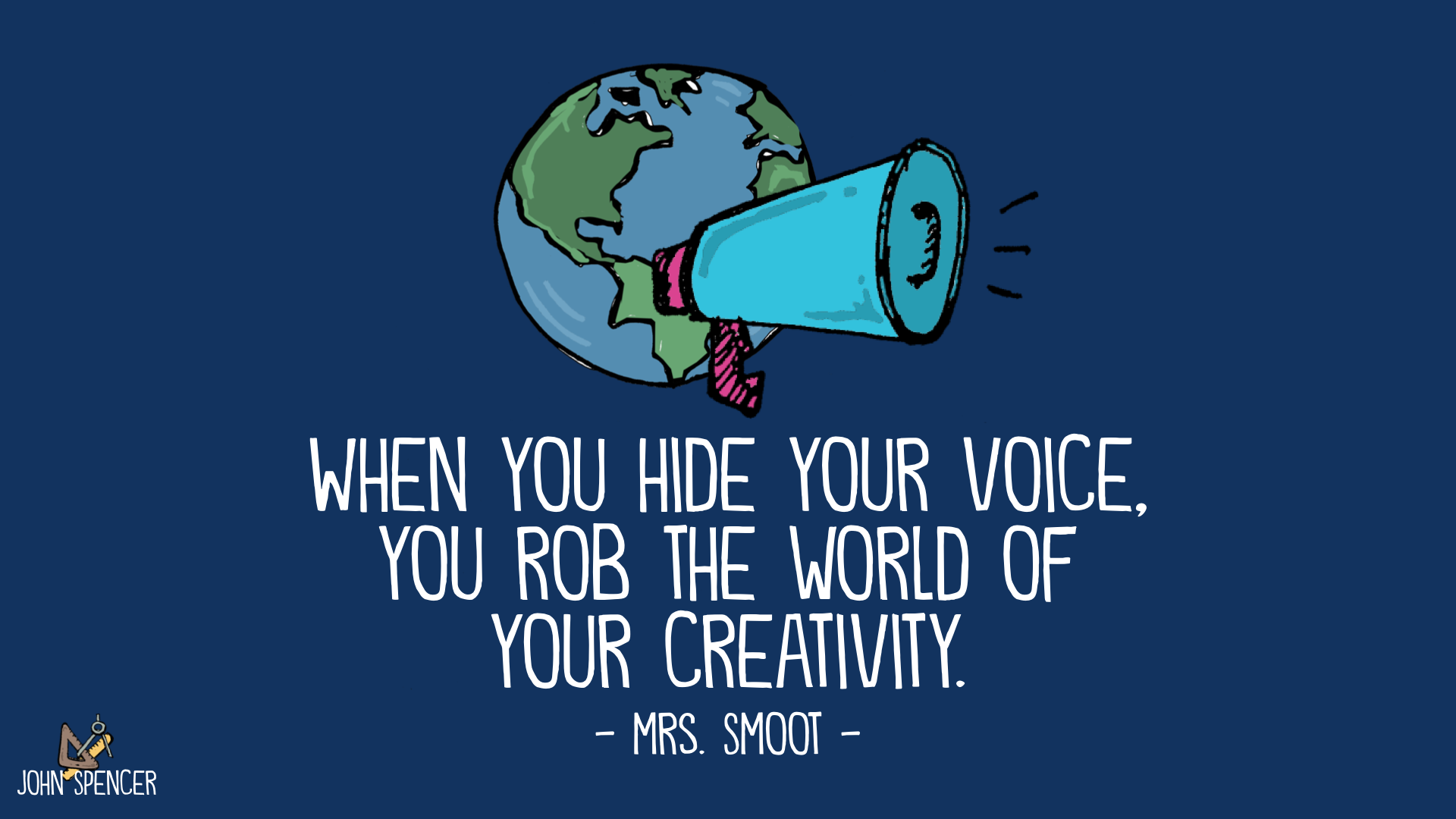 Mrs. Smoot’s words changed my life. However, the changed was gradual. I remained embarrassed by my voice for a few more years. When I took public speaking as an elective my freshman year, I froze up entirely and had to quit ten seconds into my first speech. My teacher let me try a second time. Then a third time. It was rocky but I still finished it.
Mrs. Smoot’s words changed my life. However, the changed was gradual. I remained embarrassed by my voice for a few more years. When I took public speaking as an elective my freshman year, I froze up entirely and had to quit ten seconds into my first speech. My teacher let me try a second time. Then a third time. It was rocky but I still finished it.
Both of these experiences helped me find my voice (both literally and figuratively). These experiences helped me grow in creative confidence. I still have moments when I feel insecure about my voice. It sounds tinny or nasal-y and I can tell that I failed to enunciate certain words. I can hear, for example, my failure to pronounce the “t” in the word “specialty” in that writing prompt. But overall, I am confident in my voice. This has me thinking about this idea of creative confidence and what that means in the classroom. This school year has been hard but what if this was the year we focused on developing creative confidence in our students?
Listen to the Podcast
If you enjoy this blog but you’d like to listen to it on the go, just click on the audio below or subscribe via Apple Podcasts (ideal for iOS users) on Stitcher (ideal for Android users), on Amazon Podcasts, or on Spotify.
https://spencerauthor.com/wp-content/uploads/2020/12/Creative-Confidence.mp3
The Critical Role of Creative Confidence
I recently wrote about why it’s critical for students to share their work with an authentic audience. This is true even for students who struggle with the content and who lack confidence in their creative abilities. In that article, I told the story about Marco, who struggled with writing and still found an authentic audience through blogging.
In the following sketch video, I share what happens when students share their work with an audience:
The following are a few of the things I’ve noticed when students share their work:
- They grow more empathetic because they are thinking specifically about their audience from a humble perspective.
- They work harder because the work has a deeper meaning.
- They develop a growth mindset. As they engage in the revision process, they develop resiliency.
- They learn to listen to criticism. In fact, they explicitly seek it out as a part of the revision process.
- They become fearless in their creative work.
- They engage in iterative thinking as they work through revisions to improve their work
- They make connections between the learning and their world.
- They find their creative voice.
We don’t know what the future holds for our students. If 2020 has taught anything it’s just how unpredictable life can be. However, we do know that students need to be creative thinkers and problem-solvers. They need to develop resilience in their creative work. A key part of this is the ability to develop creative confidence.
Losing Creative Confidence
Every year, when I have a new cohort of students, I ask them to do a sketchnote activity. Invariably, students grow anxious. If it’s an in-person class, I can see it as they cringe and tap their pencils. Some students start sweating and leave to get a drink of water. When I teach virtually, it’s often a black screen and a private message reading, “What if I’m not an artist?”
I’ve done this same activity with kindergartners and first graders and I rarely see the same body language. I’ve never had a six-year-old tell me, “I’m not an artist.”
Similarly, I’ve never heard a seven-year-old say, “I’m not really a creative type.” However, I have seen so many adults claim that they are simply not very creative. Part of the problem might be how we define creativity. Too often, we view it through the narrow lens of being artistic in a visual medium. It’s why we need a bigger definition of creativity:
But it’s more than that. Somewhere along the lines, many of us lose our creative confidence. It could be a bad grade in an art class or an insensitive comment from a classmate. It could be the result of a natural human tendency to compare our creative work to the people around us.
Often, though, it’s fear that kills our creative confidence. It’s the fear that your work isn’t good enough. It’s the fear that people will laugh at it or mock it or simply ignore it. In other words, it’s a fear of rejection. Every creative act is an act of vulnerability. The more we put into our work, the more exposed we tend to feel. It’s why so many artists, engineers, and makers take it so personally when people don’t like their work. As educators, we can be intentional about building our students’ creative confidence as we design our lessons and build our classroom communities.
Seven Ways to Build Creative Confidence in Students
The following are specific strategies you can use to build creative confidence in your students.
1. Don’t compare yourself to others.
If I am dealing with intense self-doubt, I find myself most tempted to try and compare myself to others. In these moments, I want to feel like I’m slightly above average (like a Lake Wobegon kid). It’s like I shrink back all of a sudden and I’m back in the fourth grade, standing at the back of the line, knowing that I might be picked last for dodge ball.
But here’s the thing: in just about every case, comparing myself to others is actually the culprit and not the solution to self-doubt. When you compare yourself to others, your only two options are arrogance and self-defeat.
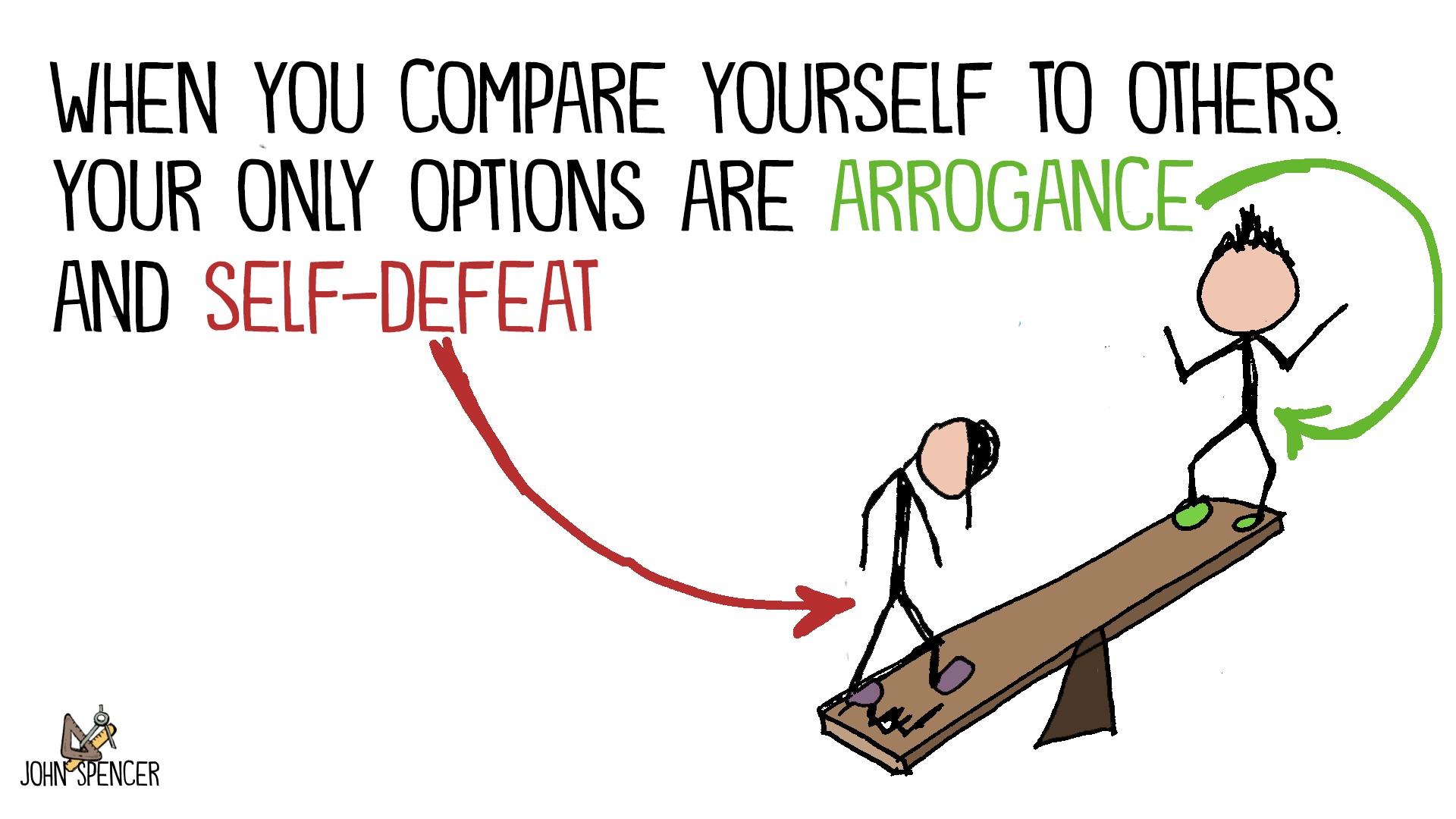
With this comparison trap, you lose sight of the community. You forget about what matters. You start seeing others as competition rather than community. You get jealous when other people get opportunities you didn’t get. You grow risk-averse. But when you let that go, you end up taking chances, reaching out to people, and doing something you love simply because you love it.
As a classroom teacher, it is a struggle to avoid the comparison trap. As a teacher, you can get rid of leveled groups and tracking. You might choose to abandon awards ceremonies and instead find ways to celebrate each student and their individual accomplishments. You can post examples of work from students at every level and find ways for students to share their work with an authentic audience. You can embed self-reflections that require all students to reflect on their strengths and weakness and thus send the message that we are all on a growth journey. I’ve found that many high achievers who seem confident are actually terrified of getting wrong answer or finding out that their work is imperfect. This is why we also need to tackle the issue of perfectionism.
2. Abandon perfectionism by focusing on growth.
I’ve met authors who never attempted to publish their work because they continued to mess with the novel indefinitely. It wasn’t simply a matter of improvement. It was a fear of imperfection. It was a false belief that the world doesn’t need to see a creative work unless it’s absolutely perfect.
I’ve met teachers who work an ungodly amount hours and burn out and everyone says, “It’s because they didn’t take care of themselves” or “It’s because they worked too many hours” or even “They just couldn’t figure out balance.” But that wasn’t it. These teachers worked insane hours because of perfectionism. They never experienced the joy of teaching because they operated out of an illusion that they had to be perfect. They bought into the myth that teachers need to be superheroes.
This perfectionism drives self-doubt. When you believe that you have to be perfect, you are never able to view yourself as measuring up. You will always feel like an imposter. In some cases, this can drive people to gossip about others or to embellish their own accomplishments.
If I could hand out any non-education book to new teachers, it would be Brené Brown Brown’s The Gifts of Imperfection. If you haven’t seen Brown’s TEDx Talk on shame and vulnerability, it’s certainly worth a listen. I am convinced that there is this disarming element to vulnerability. There’s this power in being who you are, sharing how you are actually doing, and leaning on trusted friends to remind you that you will make it as a teacher. I find that whenever I am dealing with self-doubt in creative work (whether it is writing or teaching or illustrating), vulnerability is the avenue toward getting past it.
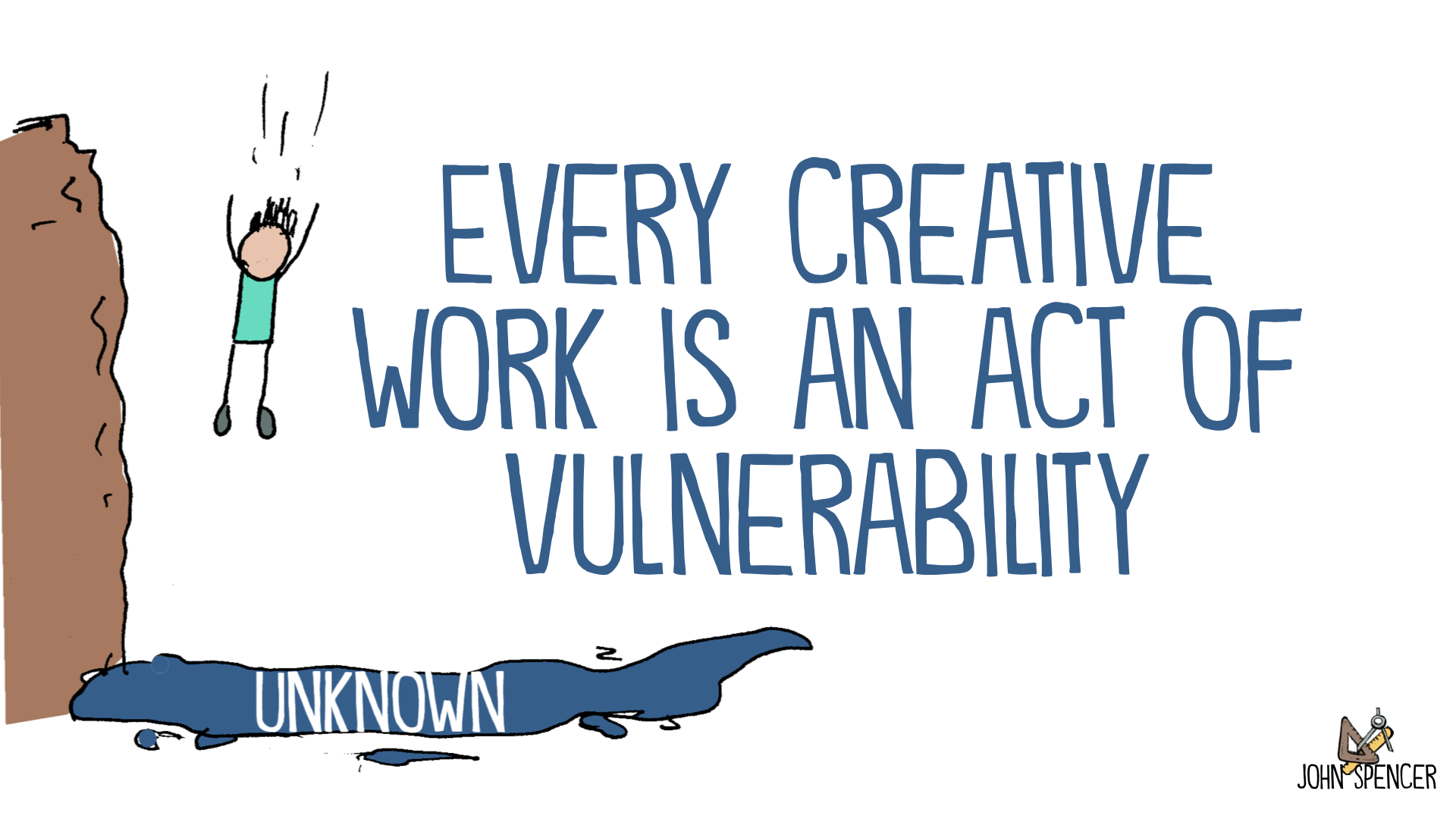
As teachers, we can help students share their struggles, ask for feedback, and plan next steps by implementing student mastermind groups. These work especially well as breakout rooms in virtual lessons:
This vulnerability can help lead to a growth mindset. Carol Dweck has shared the two different mindsets that shape how we approach tasks. In a fixed mindset, people believe that talent is fixed and that failure is proof that you simply don’t have the right natural talent. In a growth mindset, people see mistakes as a natural part of the process and view talent as something malleable.
There’s a quote from Dweck in Mindset that I think fits in well with creativity, doubt and positive risk-taking. “Everyone is born with an intense drive to learn. Infants stretch their skills daily. Not just ordinary skills, but the most difficult tasks of a lifetime, like learning to walk and talk. They never decide it’s too hard or not worth the effort. Babies don’t worry about making mistakes or humiliating themselves. They walk, they fall, they get up. They just barge forward. What could put an end to this exuberant learning? The fixed mindset. As soon as children become able to evaluate themselves, some of them become afraid of challenges. They become afraid of not being smart.” I think the same thing happens with creativity. Kids start saying things like “I’m just not artistic” or “I’m just not good at programming.”
Students grow more confident in their creativity when they focus on growth rather than talent. Here, they are able to see creativity as a skill they can improve rather than a special talent they are born with. The following are a few ways we can help cultivate a growth mindset in creative work:
- Let students resubmit their work for a higher grade. This allows students to make mistakes and improve without being punished.
- Have students set reasonable goals and track their own progress. Keep the goals focused on growth rather than achievement levels.
- Avoid tracking, ranking, and comparing.
- Implement student self-reflection and self-assessment in their creative work. This allows them to own their areas of growth.
- Shift toward a differentiated model for creative work. In other words, allow some variation on quantity (page length, word count, numbers of problems, etc.) and quality so that they don’t grow too frustrated and give up. In Flow Theory, there’s a notion of having the challenge just above the ability level. This isn’t easy to implement but when we can make it work for students, they are more likely to hit a state of flow and ultimately grow more confident.
If I have a fixed mindset, I will slip into perfectionism. I will hide how I am really doing. I will give up before I even start. However, if I see mistakes as a natural part of the growth process, I am more likely to get past perfectionism and embrace vulnerability, find my voice, and grow confident in my creativity.
4. Set Goals that are within your control.
Goal-setting is a key component of developing a growth mindset. However, the types of goals we set are a significant component. It’s important that students set goals on the areas they can control. So, if they want to publish on YouTube, their natural tendency will be to focus on subscriber counts. However, that type of goal can actually lead to defeat and a loss of creative confidence.
Students can’t own how people perceive their work. However, they do have control over both the process and the product. This is why it helps to think about process goals and product goals:
With goal-setting, we might even implement elements of gamification as we monitor our progress. The following video explores how we can gamify our creative habits:
One of the key elements of gamification is gradual increase in goals. Jon Acuff provides some great advice in Finish. He mentions setting multiple, attainable goals that gradually build up to something bigger. It’s less of an issue of whether goals are SMART or not and more about helping us see our own progress so that we don’t give up hope. So, you start out with a goal of writing 100 words per day and eventually move up to 1,000 words per day. These small wins can help students gain creative confidence but also develop creative fluency.
4. Don’t assess creativity.
When I first implemented project-based learning, I would grade students on their creativity. I focused on the inherent creativity of their finished products. This proved problematic for a few reasons. First, the assessment was inherently subjective. I tried to design a creativity rubric but it just didn’t work. Also, when I graded students on their creativity, they actually became risk-averse, which led to less creativity. They no longer felt the permission to make mistakes.
However, there’s a flip side to this. In life, we often value the things we assess. We value the quality of a post we write on Facebook when it receives more likes. It’s subtle but it’s influential. I value the number of steps I take because I have an Apple Watch and I want to close my three rings for the day. On a more qualitative note, I inherently value the time I spend with my family but I also value that time even more when I am conscious about reflecting on the time we spend together. Assessment creates awareness and often helps us see our progress. If we don’t assess creativity, we can slip into a mindset where we don’t value it.
So, on one hand, if we assess creativity it backfires. However, if we don’t assess it, we fail to emphasize it. So, what’s solution? Part of the answer is to celebrate creativity. We don’t always think of celebrations as a form of assessment but they are a powerful way we assess our progress. Teachers can use progress and badges to have students track their creative skills, or creative habits. Another solution is to have students self-assess both their creative process and their creative progress.
So, instead of grading for creativity, have students engage in self-assessment and peer assessment in their creative work. An assessment focused on process might be a survey students take about their creative risk-taking or their resilience when faced with roadblocks. Or it might be a quick divergent thinking challenge where they track their progress on how well they can think divergently in a challenge (such as how many items you can create with two separate items). However, they can also self-assess on the inherent creativity of their finished products with reflective questions about how original their product is or how well it solves a practical problem or even how empathetic the product is now that it connects to an audience. The critical piece here is that students own the assessment process and as a result they can focus on the growth and ultimately improve in their creative confidence.
5. Make creativity a daily habit.
I am not confident in my ability to dance. Part of this is my genuine lack of knowledge and my pace in learning dance moves. In P.E., the teacher would explain 3 steps and we’d practice it but I would only master one step. Then we’d have three more steps and I’d already be lost. This next year, I want to learn how to dance. Fast dance. Slow dance. Salsa. Swing dance. I want to learn to dance because when the pandemic is over, I want to dance with my wife. For me, the real issue isn’t just the lack of knowledge, it’s the lack of experience in dancing.
Experience is critical for confidence. Think about driving. When you first learning to drive, you were likely scared. But over time, you grew more confident and more skilled. There’s an early phase where mistakes are more frequent, the skill level is lower, and confidence is really low. Over time, the mistakes decrease, the skill level increases, and the confidence becomes solid. We often have an increase in self-efficacy, or the belief in our ability to accomplish the task. Note that there is a dark side to this. If self-efficacy is too high, we can grow overconfident in our ability and we fail to pay attention to the task at hand. In the case of driving, frequent, experienced drivers can end up getting in car accidents because they are too comfortable. This is why so many of the accidents happen close to home.
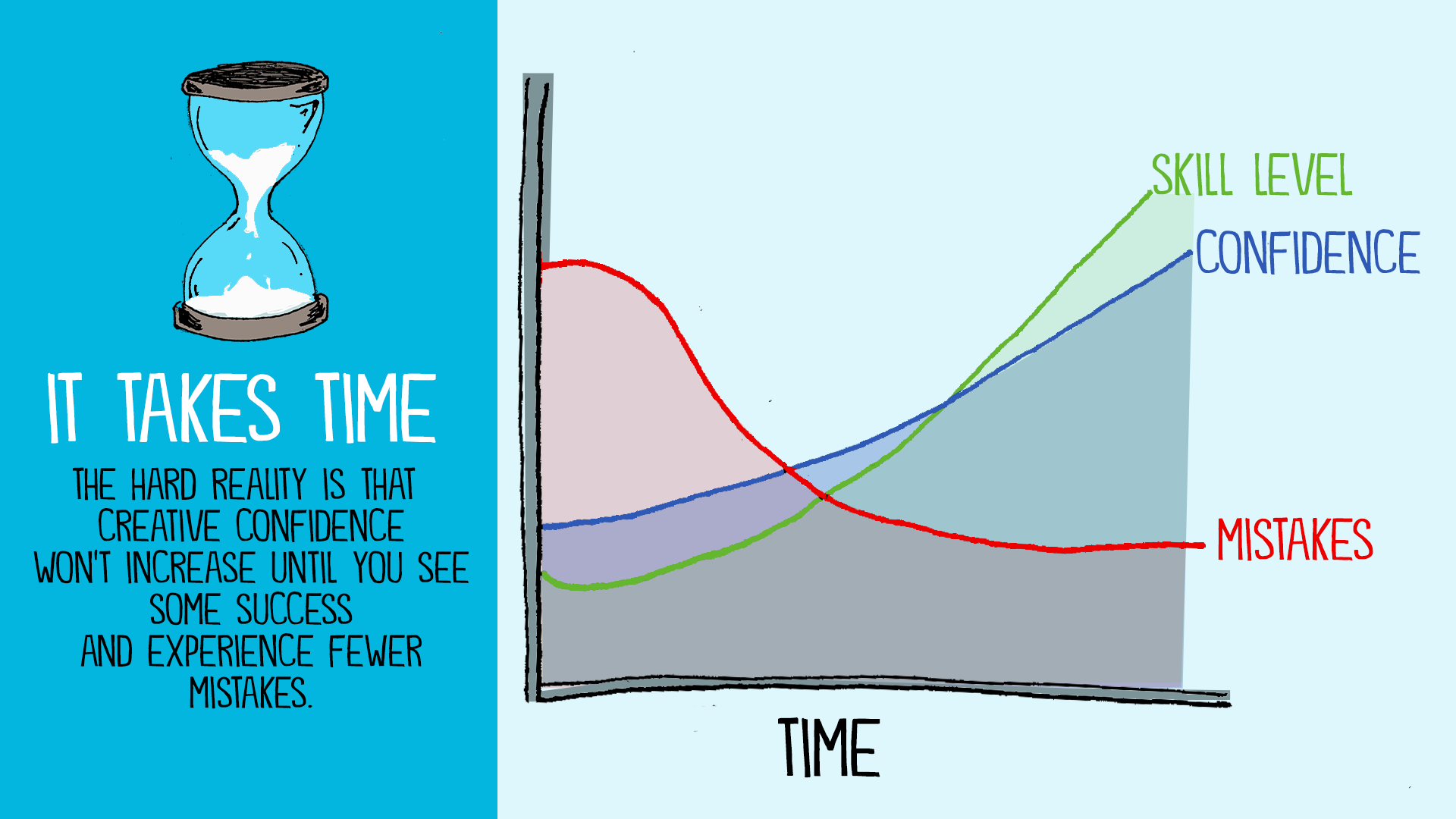 The takeaway for students is that creative confidence requires hours of creative work. There’s no shortcut or workaround. Students simply need to engage in creative work for a longer period of time if they want to develop creative confidence. As teachers, we can implement project-based learning, design thinking, and inquiry-based learning. We can have students engage in multimedia composition such as journalism. We can have students engage in problem-solving and divergent thinking.
The takeaway for students is that creative confidence requires hours of creative work. There’s no shortcut or workaround. Students simply need to engage in creative work for a longer period of time if they want to develop creative confidence. As teachers, we can implement project-based learning, design thinking, and inquiry-based learning. We can have students engage in multimedia composition such as journalism. We can have students engage in problem-solving and divergent thinking.
6. Treat Your Work Like an Experiment.
One of the ideas I love in the start-up world (Lean Startup in particular) is the concept of pivoting. It’s the idea that you have something that remains steady (your goals, your vision, your core product) but that you pivot around that in order to figure out what works. Everything is an experiment. It’s the notion of teaching in perpetual beta.
So, instead of being mired in self-doubt, you get to treat your work as an experiment. If it didn’t work, it’s not a failure. It’s a chance to figure out what doesn’t work. In this view, the biggest risk isn’t failing. The biggest risk is doing nothing. This is admittedly difficult in the high-stakes environment of standardized testing. You are often placed in a situation where mistakes are not okay and where experimentation is frowned upon. I don’t have an easy answer. However, I think this is where courage plays a role in creativity and innovation. Being different is risky. Experimenting can be humbling when your school culture doesn’t embrace it.
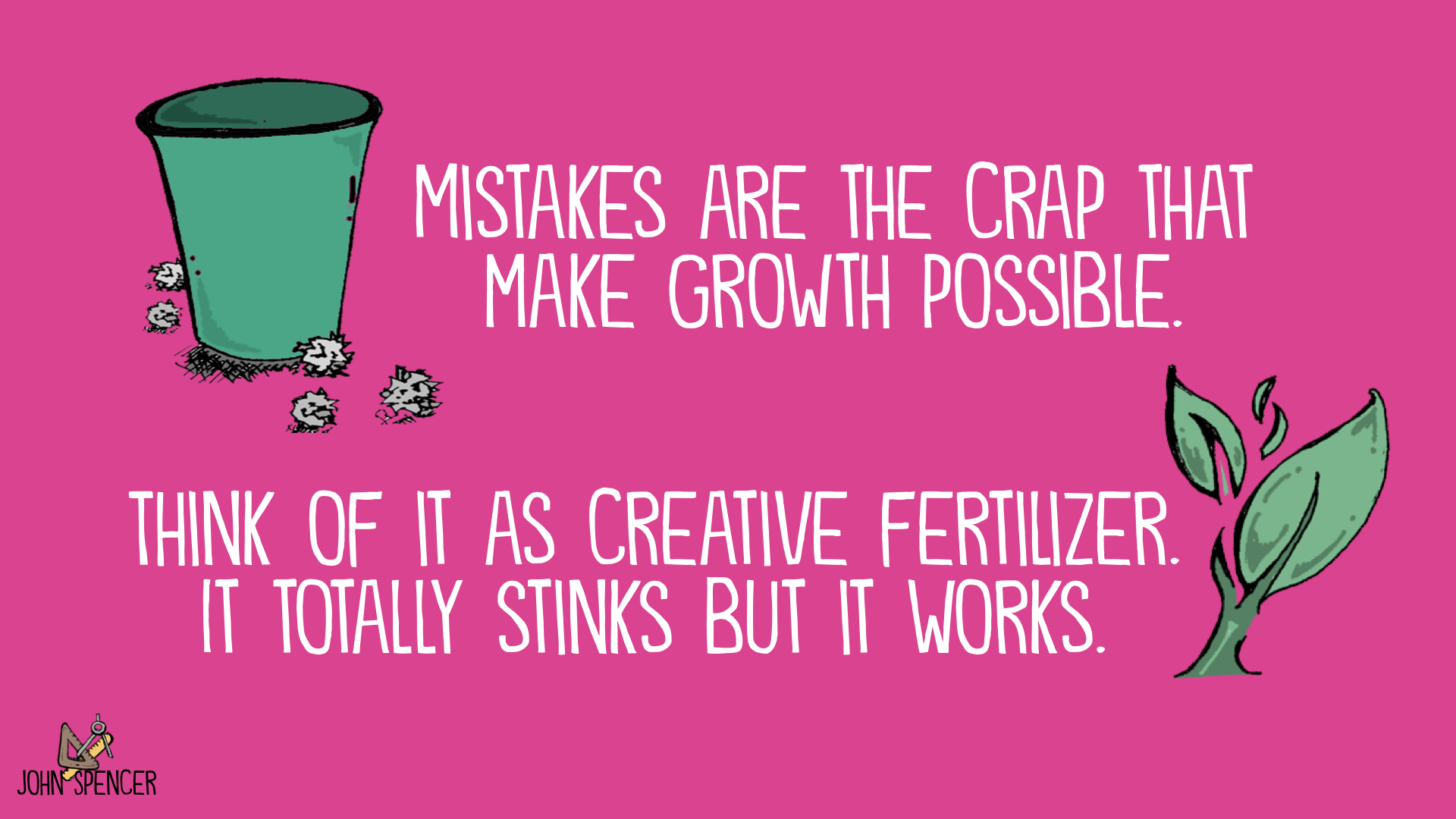 Mistakes aren’t fun but they are what make growth possible. The following continuum explores what students can do when they have projects that fail.
Mistakes aren’t fun but they are what make growth possible. The following continuum explores what students can do when they have projects that fail.
This process builds on student autonomy and agency and sends the message that mistakes are okay. We don’t want students to embrace failure so much as failing. Fail-ure is permanent but fail-ing is a temporary part of the learning process.
7. Create a high-pressure scenario but provide a safety net.
Earlier in this article, I shared the story of two experiences that helped me find my voice. In both cases, I had teachers who believed in me when I didn’t believe in myself. These teachers didn’t shelter me from high-stakes situations. Both the History Day Competition and the speech were high-pressure for a shy kid. However, they coupled this high-stakes element with the permission to make mistakes. In other words, I developed grit because they gave me slack.
We see this phenomenon in all kinds of creative work. In theater, there is a high stakes moment when actors have to perform in front of a live audience. However, there’s a rehearsal phase where they are able to make mistakes and grow. Similarly, in design thinking, there is a revision stage before the high-stakes launch. If you’ve ever watched Apollo 13, you’ll likely remember the scene where they have to solve a complex problem with limited time and resources. It was a truly high-stakes moment in every way imaginable. However, that multidisciplinary team had spent years working together in rehearsals where they analyzed their mistakes and focused on growth.
When students have a high-stakes scenario, they are likely to face fear and anxiety. However, as unpleasant as that may be, they also grow from it and learn that it wasn’t quite as scary as they had thought. Over time, they grow less and less anxious. By adding a safety net, students have a safe space to make mistakes along the way. Eventually, they grow fearless in their creative work.
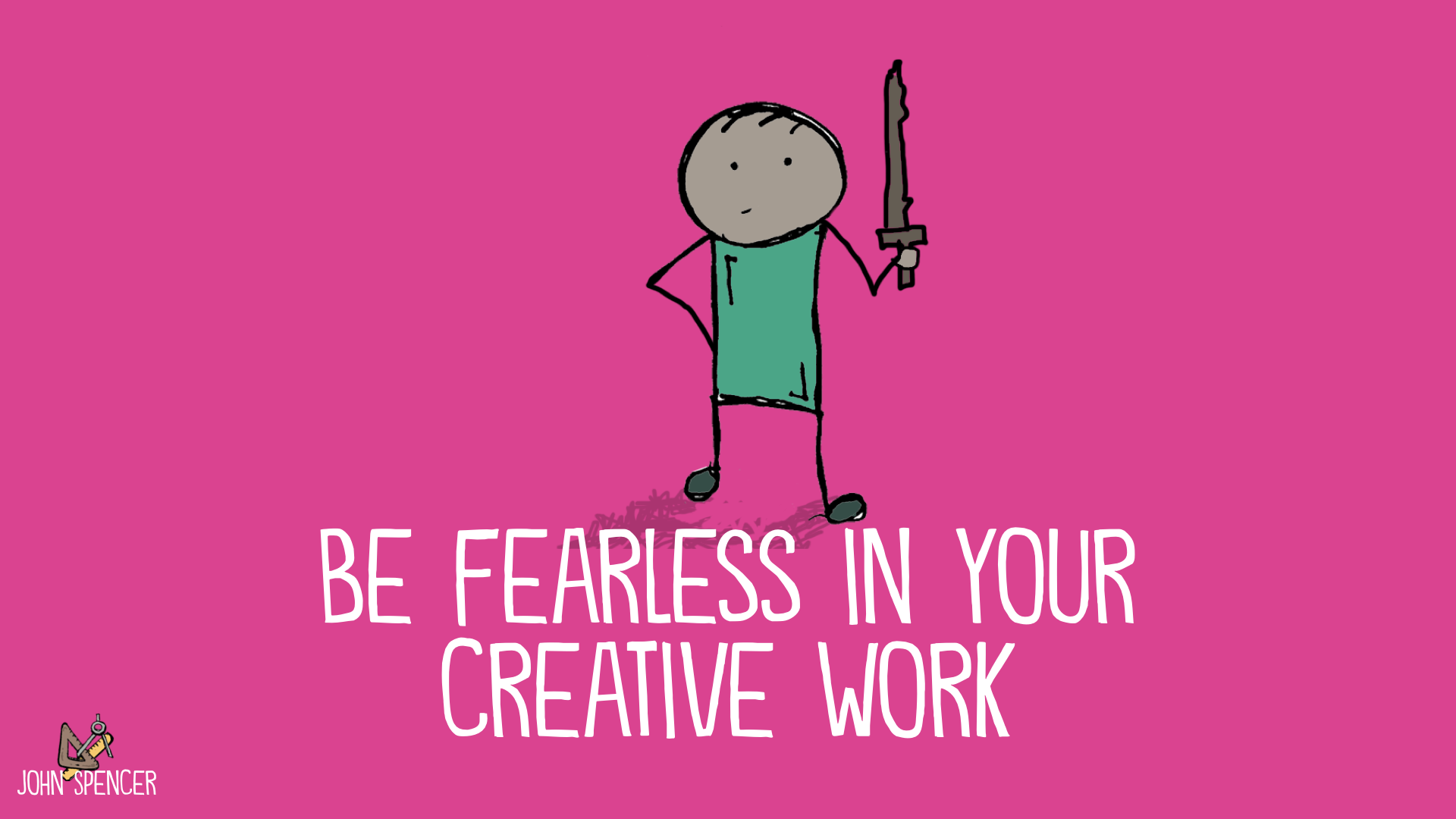 Ultimately, students who gain creative confidence are able to find their creative voice and discover more about themselves. They’re able to be known.
Ultimately, students who gain creative confidence are able to find their creative voice and discover more about themselves. They’re able to be known.
Teachers Are Key to This Process
Growing up, I was insecure about my voice. I had a great speech therapist and I had parents who were wonderful and supportive. However, I knew my parents would be encouraging no matter what. I needed outside validation and affirmation to find my voice. That came in the form of a teacher.
Teachers can design the learning activities to focus on creative confidence. They can build the classroom community with a focus on growth and experimentation. They can design structures that facilitate a growth mindset. They can get to know their students and build relationships where they can affirm students in their creative work.
The post 7 Ways to Build Creative Confidence in Students appeared first on John Spencer.
